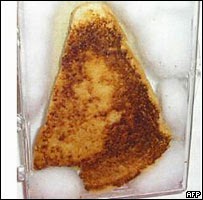Along the same line of mental wiring of pattern recognition is our ability to make out a human face in general, whether it is in the shadows behind a bush or in objects in your closet. So similar to the example offered by Michael Shermer in his book The Believing Brain, if you percieve a face behind a bush and it turns out to be a potential enemy, you have more time to act for your safety. However, if you percieve a face behind a bush and it turns out to be an odd arrangement of branches, then you are still safe and no harm is done.
So given the advantage of this kind of neural software, we have ended up with an abundance of general pattern recognition especially regarding faces. Even in modern day, it's advantageous to know if there is someone skulking around your house and the no harm alternative is when we percieve a 'man in the moon'. As further examples, we have found humor in eBay auctions of buttered holy toast with the 'image' of the virgin Mary. This is about the norm. Most of us have the potential to percieve faces anywhere, even in a simple figure with basic shapes such as- :) - which is interpreted as a face.
We now know that it is possible for this 'software' to breakdown as a result of a number of different traumas to a particular part of the brain. And one manifestation of this 'software breakdown' is referred to as Prosopagnosia. Oxforddictionaries.com mentions that the word is derived from the greek prosōpon for face and agnōsia meaning ignorance. More commonly this is referred to as face blindness.
The first recorded case of this was documented by Wilbrand in 1892 (see this excerpt from Solms and Brown by Vanderbilt University Press for more reading) Essentially, when this portion of the brain is interfered with from tumor, lesion, or damage, the ability to recognize a face, any face can be inhibited or completely lost.
A classic example of this is found in the book from Dr. Oliver Sachs, The Man Who Mistook His Wife For a Hat . This shows the story of one man who lost his ability over time to recognize individual faces except by using particular features like "a chipped tooth" or even auditory queues like the pitch of someone's voice. Imagine, if you will, walking into your office and immediately analyzing your surroundings for the hairdo your boss always has so you can say "Good Morning, Susan" to the correct person. Or coming home from work to a few people greeting you for your birthday when one grabs you and expresses their love with a kiss yet you can't identify who it was, since your wife and 2 other women turned out to be wearing purple that night.
Feel free to explore other possible scenarios in the comment section below ;) I trust you know what that symbol is too!


No comments:
Post a Comment